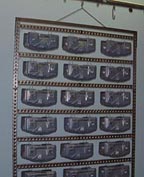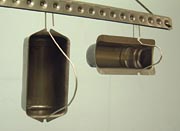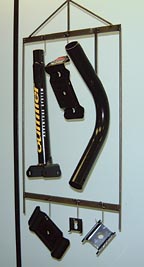Using Racks to Increase Profits
People who know finishing systems do not have to be convinced that racking can make or break profits. Profitability requires density, and density requires good racking. Good rack design begins by answering some basic questions relative to both the finishing system and the parts themselves. Below is a list of system-related and parts-related questions you should ask prior to the design process of your racks.



If you ask these questions prior to having racks designed for your coating operation, you will set your shop up to have the optimal line density possible. Reduced waste via less paint overspray results in a heftier bottom line, helping you rack up higher profits.
Q. To achieve the optimum line density, what should the maximum rack width be?
Allowing a minimum of 3" clearance at the top and bottom of the system's smallest opening, measure the remaining vertical dimension. This is the vertical painting area of the maximum rack length. If automatic spray guns are being used, be sure to consider the size of the spray pattern and the amount of time on target, especially if reciprocators also are being used.Q. Does the conveyor have inclines and declines and what is the maximum degree of angle?
Using the steepest degree of incline or decline, calculate the maximum rack width. An engineer or a reputable racking company should be able to help you with this calculation.
A modular powder coating rack like this one may be suitable for your application needs.
Q. What type of hanging attachment is on the conveyor to be used for rack control?
Determine the best method to control a pivoting single point (center hung) conveyor hook. Single point conveyor hooks work best on inclines, declines and around turns. The rack will remain vertical at all times, eliminating shifts in gravity, and there will be no binding on turns due to the shorter distance between hang points.Q. Will the racks be cleaned in a burn-off oven?
If so, the rack materials, particularly parts hooks, must withstand 800°F temperatures. If spring tension is required, stainless must be the material of choice because common spring materials will be annealed at lower temperatures and lose their strength and spring properties.Q. Is painting going to be done from both sides of the conveyor?
If not, the rack will most likely need to be rotated by the painter, limiting the width of the rack. A flat rack is usually the rack of choice over a column rack design, which is rotated at the same time as the parts are being sprayed. Time on target is critical with this design.
Racks used in dip or wet spray applications must usually hold the parts by a minimum of two points for control against air pressure and to eliminate flotation and loss of electrical contact.
Q. Is the finishing system wet spray, powder coating or dip?
Racks used in dip or wet spray applications must usually hold the parts by a minimum of two points for control against air pressure and to eliminate flotation and loss of electrical contact. Racks used for powder coating must have the hook's contact points cleaned every four to eight cycles to maintain the electrostatic ground between the hook and the part. It is desirable if the hooks and rack parts are removable for cleaning even with paint buildup on the rack.Q. Will the racks be used for washing (cleaning) the parts as well as painting?
Small parts often fall off of paint racks by the pressure of the wash system. Therefore, the hooks must be designed to specifically retain the parts. Other parts may hold liquids from the wash system and carry them over into the paint booth. These parts must be held with specific hooks to allow the parts to drain.
This rack has been made to accommodate a family of parts.
Q. Will the rack need to be adjustable or dedicated to one part?
Adjustable racks should be designed to shield the connecting points of the hooks and crossbars to provide adjustability between cleaning cycles.Q. Does the part require any masking?
The rack can sometimes be designed to hold and mask the part with the same hook. If the mask can be made of steel, it can be permanently attached and cleaned with the rack.Q. Does the part require 100 percent coverage or just one side?
If the part requires only one side to be painted, design the rack to hold parts back to back, which increases density and saves paint.If you ask these questions prior to having racks designed for your coating operation, you will set your shop up to have the optimal line density possible. Reduced waste via less paint overspray results in a heftier bottom line, helping you rack up higher profits.
Looking for a reprint of this article?
From high-res PDFs to custom plaques, order your copy today!



